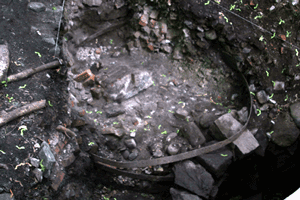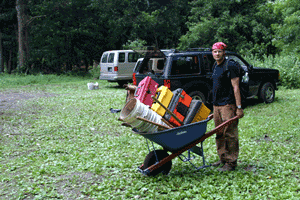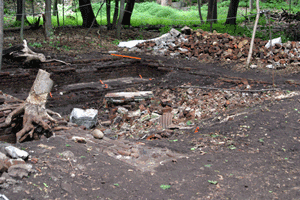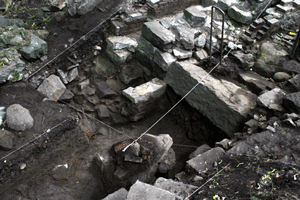At the Boring Mill, Ed Tennant and Paul White uncovered a grease pit below the likely location of a large wheel shown in historical photographs. The oil saturated subsoil revealed artifacts in like new condition, including timbers, iron and brass, and even a few scraps of newspaper. Suika Rivett finished the unit she was working on last week and opened a new area to expose the top of a brick machine base.

The
full extent of the cylinder bands were exposed this week up at the Blowing
Engine. SELECT
ON PHOTOGRAPH TO ENLARGE
A
view of Pat's excavation unit in the Blowing Engine showing the northern
lintel.
SELECT
ON PHOTOGRAPH TO ENLARGE
Other events at the Foundry this week include visits by photographers from Scenic Hudson and American Archaeology magazine. The photographs for Scenic Hudson will be used for informational and promotional materials. American Archaeologist is preparing and article about Michigan Tech’s work at the West Point Foundry.
The crew woke up to pouring rain on Tuesday morning, so we visited the ----Clove Furnace, a blast furnace in Orange County, New York. This furnace is also known as the Greenwood Furnace #2. Owned by Robert Parrott’s brother Peter, it was the source of much of the pig iron used at the West Point Foundry after the final blast in the furnace in Cold Spring.
All in all, it has been an exciting summer at the Foundry, with a tremendous amount of data generated and features discovered. The next two weeks will be spent excavating the few remaining areas needed to address the research questions posed this summer, as well as completing documentation of the existing units. An open house the last weekend of July will keep the entire crew busy (10-3, rain or shine, Sat. July 31 & Sun. Aug 1). This will be followed by a week of frenzied backfilling to conclude the excavations this summer.
Pat Baird

Pat
at the end of a long day, rolling equipment down from the Blowing Engine.
SELECT
ON PHOTOGRAPH TO ENLARGE

